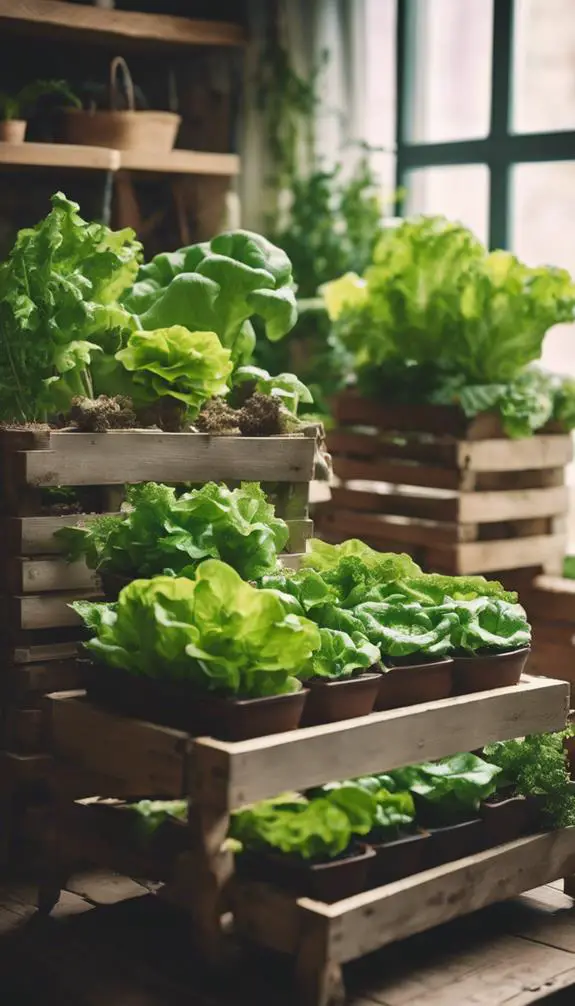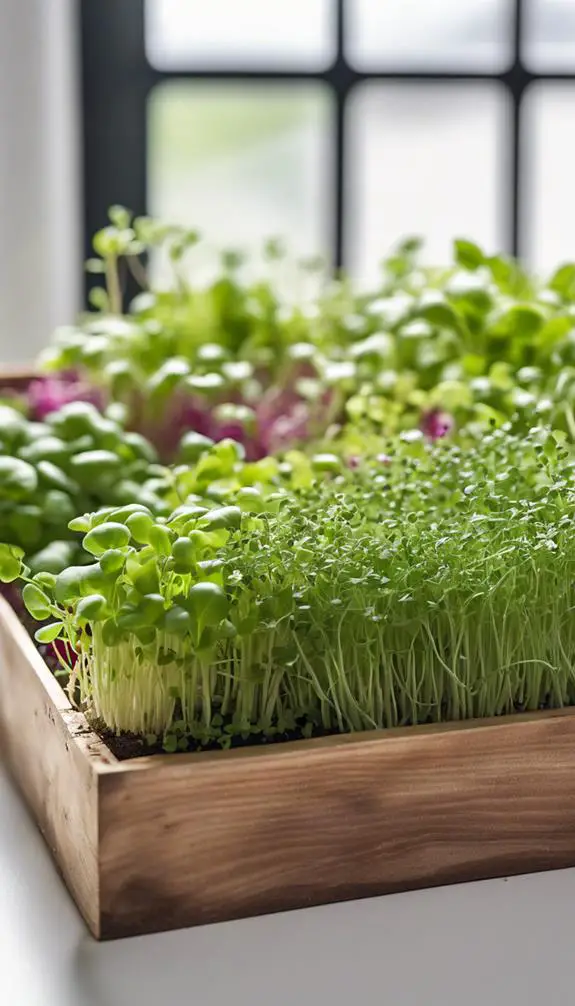As you consider growing lettuce year-round, you're likely wondering what it takes to enjoy a steady supply of fresh, crisp leaves 365 days a year. It's not as intimidating as it sounds, and with the right strategies, you can successfully cultivate lettuce even in the dead of winter. By choosing the right variety, mastering the art of succession planting, and creating a prime growing environment, you'll be on your way to a bountiful harvest. But what specific techniques will give you the edge you need to overcome common obstacles and guarantee a continuous supply of fresh lettuce?
Summary
- To grow lettuce year-round, use succession planting, sowing new seeds every 1-2 weeks to maintain a continuous harvest.
- Provide precise light control, with partial shade and 10-12 hours of light exposure daily, to prevent bolting and promote leafy growth.
- Manage temperature between 60°F and 70°F (15°C and 21°C) for ideal growth, using shading, ventilation, or cooling systems as needed.
- Use a balanced, water-soluble fertilizer at planting and again 7-10 days later, avoiding overfertilization, and maintain consistent moisture levels.
- Utilize cold frames or indoor growing conditions to extend the growing season, providing a protected environment for lettuce to thrive in cooler temperatures.
Choosing the Right Lettuce Varieties
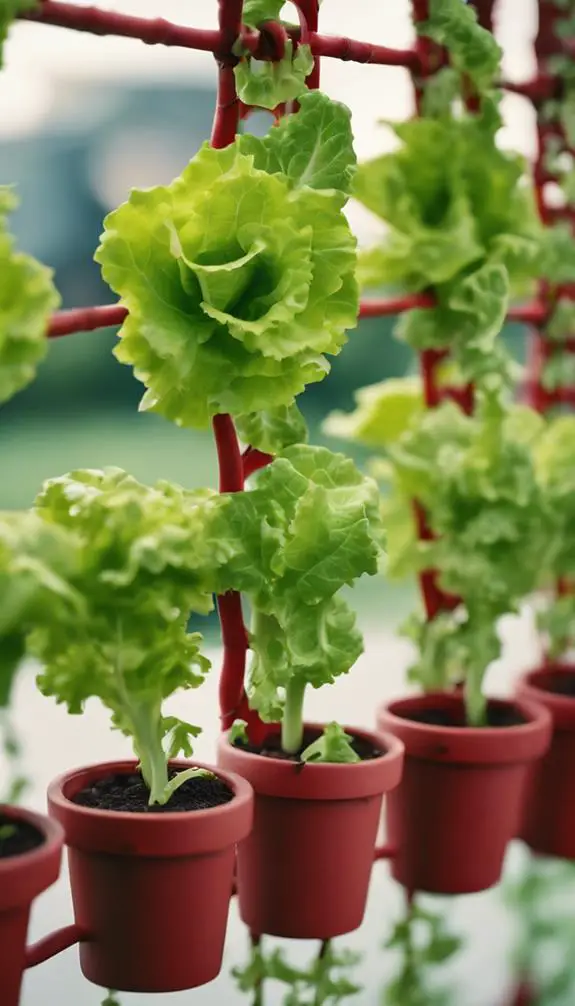
When selecting lettuce varieties for year-round growth, you'll want to focus on types that thrive in your local climate and provide a continuous harvest.
Lettuce breeders have developed numerous varieties with distinct characteristics, ensuring there's one suitable for your region.
Consider leaf texture, as it affects the lettuce's overall quality and shelf life.
Loose-leaf varieties, such as 'Red Leaf' and 'Green Leaf', have a tender, delicate texture, while romaine and buttercrunch types have a crisper, more robust texture.
By choosing varieties with the right leaf texture and climate tolerance, you'll be able to harvest fresh lettuce throughout the year.
Research and experiment with different varieties to find the perfect fit for your garden and palate.
Understanding Lettuce Growth Cycles
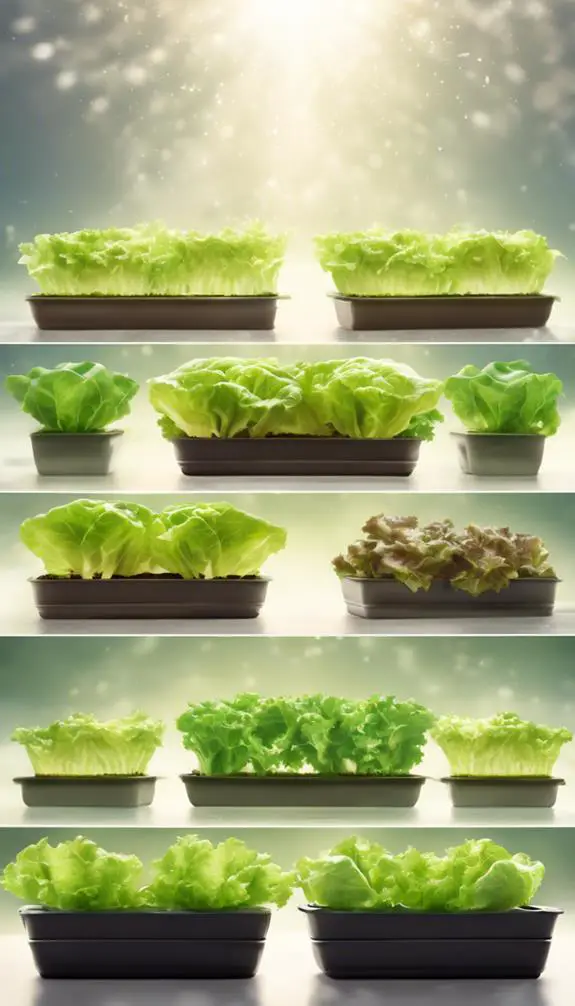
Lettuce growth cycles are influenced by factors like light, temperature, and moisture, which affect the plant's development from germination to maturity.
You'll want to understand these factors to optimize your growing conditions.
Lettuce anatomy plays a vital role in its growth cycle, with the plant's rosette shape allowing it to absorb light and nutrients efficiently.
As you grow lettuce, you'll notice the formation of leaves, stems, and roots, each with its unique function.
Growth regulators, such as hormones and growth promoters, can be used to manipulate the growth cycle, increasing yields and improving quality.
Preparing Soil for Lettuce

When preparing soil for lettuce, you'll want to focus on creating a well-balanced composition that supports healthy growth.
Lettuce thrives in soil rich in organic matter, which improves drainage, aeration, and water-holding capacity.
Soil Composition Matters
Rich, dark humus teems with life, and vitally, you must establish this fertile foundation for your lettuce crop.
To achieve ideal soil composition, you'll need to balance acidity and nutrient levels. Lettuce prefers a slightly acidic to neutral soil pH, ranging from 6.0 to 7.0.
Test your soil to determine its acidity, and adjust accordingly. A balanced nutrient profile is also essential, with nitrogen, phosphorus, and potassium (NPK) being the primary macronutrients.
Aim for a balanced NPK ratio of 10-10-10 or 20-20-20. Additionally, incorporate micronutrients like iron, zinc, and boron to promote healthy plant growth.
Lettuce Loves Organic
Now that you've balanced your soil's acidity and nutrient levels, it's time to prepare the soil for your lettuce crop by going organic.
Lettuce thrives in soil rich in organic matter, which improves soil structure, water-holding capacity, and aeration.
Compost benefits your lettuce crop by providing a slow release of nutrients, suppressing diseases, and attracting beneficial microorganisms. Add a 2- to 4-inch layer of compost to your soil and mix it well.
You can also use other organic amendments like well-rotted manure, leaf mold, or green manure. These will help create a nutrient-rich environment that fosters healthy lettuce growth.
Sowing Lettuce Seeds Indoors

You'll need a few basic supplies to get started with sowing lettuce seeds indoors.
Gather seed starting trays or small pots, a good quality potting mix, and lettuce seeds specifically bred for indoor growth.
Create an ideal indoor climate by positioning your seedlings near a south-facing window or under grow lights, maintaining a consistent temperature between 65-75°F (18-24°C).
Sow seeds about 1/8 inch deep and 2-4 inches apart, then gently mist the soil.
Keep the soil consistently moist, but not waterlogged.
As seedlings emerge, guarantee they receive adequate light and maintain a humid environment to promote healthy growth.
Sowing Lettuce Seeds Outdoors

When transplanting lettuce seedlings outdoors, choose a location that receives partial shade to full sun, depending on your climate and the lettuce variety.
Before sowing, prepare the soil by loosening it to a depth of 8-10 inches. Sow seeds at the correct depth, typically 1/8 inch for smaller varieties and 1/4 inch for larger ones.
Space them 2-4 inches apart, in rows 12-18 inches apart. Check the lettuce timing, as some varieties mature faster than others.
Sow seeds every 1-2 weeks for a continuous harvest. For ideal growth, maintain consistent moisture and keep the soil cool, around 60-70°F (15-21°C).
Controlling Light for Lettuce

Lettuce requires precise light control to thrive. You'll need to guarantee it receives the right amount of light intensity to promote healthy growth.
In outdoor settings, you can achieve this by providing partial shade, especially during peak summer months.
For indoor growing, consider using artificial lighting. LED grow lights are an excellent option, as they offer adjustable light intensity and spectrum.
Aim for 10-12 hours of light exposure daily, with an intensity of 20-40 watts per square foot. This will encourage leafy growth and prevent bolting.
Managing Temperature for Lettuce

Temperature plays a vital role in lettuce growth, and managing it correctly is essential for maximum yields.
You'll need to ponder lettuce hardiness, as some varieties are more sensitive to temperature fluctuations than others. Generally, lettuce prefers cooler temperatures between 60°F and 70°F (15°C and 21°C) for ideal growth.
Thermal regulation is pivotal, as temperatures above 75°F (24°C) can lead to bolting, a premature flowering that reduces leaf quality. You can achieve thermal regulation by using shading, ventilation, or cooling systems, depending on your growing setup.
Watering and Fertilizing Lettuce

Having confirmed ideal thermal conditions, you can now focus on providing your lettuce with the necessary hydration and nutrients.
Lettuce hydration is vital, as consistent moisture promotes healthy growth and prevents bolting. Water your lettuce when the top inch of soil feels dry to the touch, taking care not to overwater, which can lead to root rot.
For fertilizer timing, apply a balanced, water-soluble fertilizer at planting and again 7-10 days later. This provides essential nutrients for leaf development. Avoid overfertilizing, as this can cause more harm than good.
Succession Planting for Continuous Harvest

You'll want to plant new lettuce seeds every 1-2 weeks to maintain a continuous harvest.
By staggering your sowing schedule, you'll guarantee that new plants are maturing just as others are being harvested.
Plant Every 1-2 Weeks
To guarantee a continuous harvest of fresh lettuce, plant new seeds every 1-2 weeks, a technique known as succession planting.
This approach allows you to manage lettuce frequency and certifies a steady supply of crisp, fresh leaves. By staggering seed sowing, you'll avoid having all your lettuce mature at once, preventing gluts and shortages.
This method also enables you to adapt to changing weather conditions and pest pressure. Simply put, succession planting is key to maintaining a consistent and bountiful lettuce harvest throughout the year.
Staggered Sowing Schedule
A staggered sowing schedule is crucial for achieving a continuous harvest of fresh lettuce.
To implement this, create a lettuce calendar that outlines your sowing rhythm. Divide your growing season into smaller intervals, typically 1-2 weeks, and sow a new batch of lettuce seeds at the start of each interval.
This guarantees that as one batch is reaching maturity, the next is just getting started. By staggering your plantings, you'll maintain a consistent supply of fresh lettuce throughout the year.
Adjust your sowing schedule based on factors like weather, climate, and lettuce variety to optimize your harvest.
With a well-planned staggered sowing schedule, you'll enjoy a continuous flow of crisp, delicious lettuce all year round.
Overlapping Maturity Dates
By cleverly overlapping maturity dates, you can guarantee a continuous harvest of fresh lettuce without gaps or gluts.
To achieve this, create a lettuce calendar that outlines the sowing and harvesting dates for each batch of lettuce.
Stagger the sowing dates by 7-10 days to certify a steady supply of fresh lettuce.
Consider plant spacing when planning your overlapping maturity dates.
For example, if you're planting loose-leaf lettuce with a 40-day maturity date, plant a new batch every 20-25 days, spacing them 2-3 inches apart.
This will allow you to harvest a continuous supply of fresh lettuce while minimizing waste and verifying a consistent flavor profile.
Using Cold Frames for Year-Round Growth

While lettuce thrives in cooler temperatures, winter's chill can still be detrimental to its growth.
You can extend the growing season by using cold frames, which provide a protected environment for your lettuce to thrive. When building a cold frame, consider the construction materials and design.
A well-insulated frame with a transparent top allows for sunlight penetration and heat retention. You'll also need to guarantee good air circulation to prevent moisture buildup.
For frame maintenance, regularly inspect the structure for damage and clean the transparent top to maintain transparency. Additionally, monitor temperature and humidity levels to secure ideal conditions for your lettuce.
Extending the Growing Season
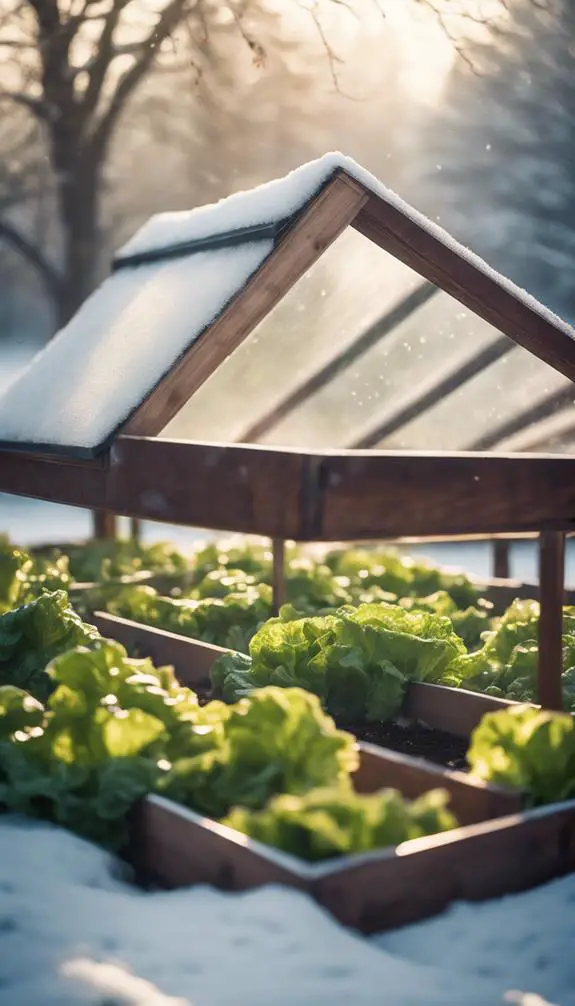
You'll extend the growing season by utilizing cold frames, which provide benefits like frost protection and improved soil temperature.
With these structures, you can start sowing lettuce seeds in early spring, about 4-6 weeks before the last frost date in your area. This head start allows you to harvest fresh lettuce leaves before traditional outdoor growing conditions are suitable.
Cold Frame Benefits
Extend your growing season with cold frames, which can add weeks or even months to the lettuce-growing calendar.
By using cold frames, you can grow lettuce in cold climates, where the temperature drops below 40°F (4°C). The frame design allows you to control the environment, providing protection from harsh weather conditions.
In a cold climate, a well-designed cold frame can maintain a temperature 10-20°F (5-10°C) higher than the outside temperature, making it ideal for lettuce growth.
Early Spring Sowing
As the last wisps of winter's chill dissipate, cold frames beckon you to sow lettuce seeds, capitalizing on the season's earliest opportunities.
This early start allows you to get a head start on the growing season, giving your lettuce a chance to mature before the weather warms up.
Begin by preparing your cold frame for spring, ensuring it's clean and free of debris.
Then, sow your lettuce seeds about 2-3 weeks before the last frost date in your area.
This will give them a chance to germinate and establish themselves before the weather warms up.
With proper spring preparation, you'll be enjoying fresh, crisp lettuce in no time.
Protecting Lettuce From Pests and Diseases
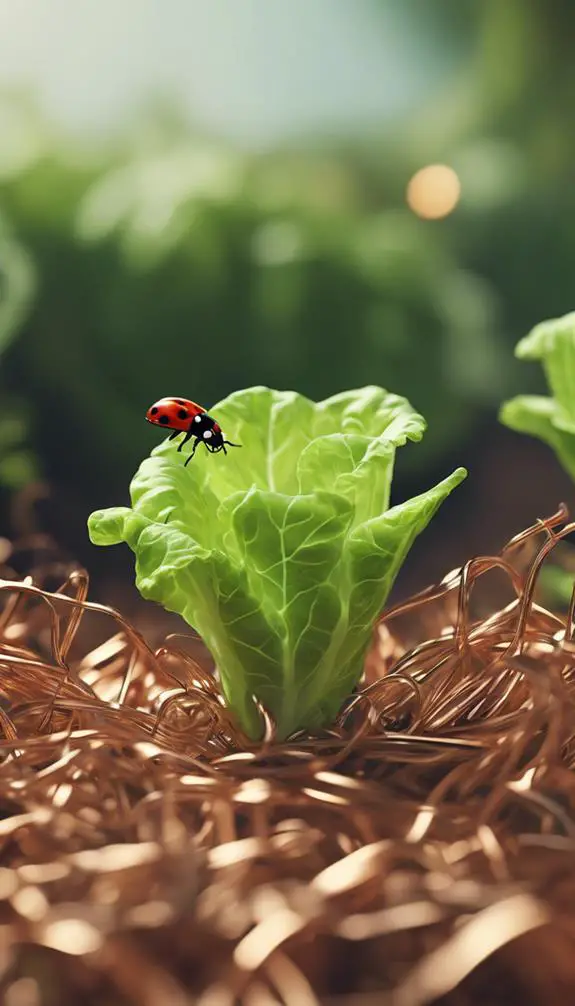
Lettuce crops are vulnerable to a variety of pests and diseases that can decimate your harvest, making protection a crucial aspect of year-round lettuce production.
You'll want to take proactive measures to prevent infestations and infections. Consider using lettuce cages to keep slugs and snails at bay. Row covers are another effective barrier against pests like aphids and whiteflies.
These physical barriers can also help prevent disease transmission. Additionally, maintain good garden hygiene by removing weeds and debris that can harbor pests and diseases.
Regularly inspect your plants for signs of trouble, and take action quickly if you notice any issues. By taking these steps, you'll be well on your way to a healthy, pest- and disease-free lettuce crop.
Troubleshooting Common Lettuce Growing Issues
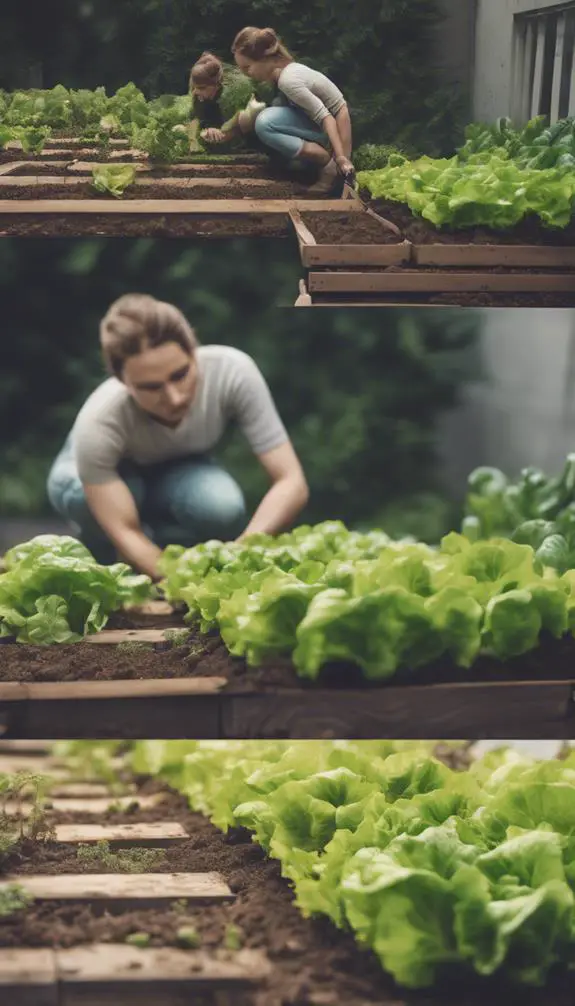
You've taken the necessary steps to protect your lettuce crop from pests and diseases, but even with the best precautions, issues can still arise.
One common problem is lettuce bolting, where your plants suddenly grow tall and produce seeds, rendering them inedible. This can occur when lettuce is stressed, so confirm you're providing consistent moisture and temperatures.
Weak stems are another issue, often caused by inadequate light or insufficient calcium. To combat this, provide supplemental lighting and maintain a balanced fertilizer regimen.
Monitor your plants closely, and address any issues promptly to prevent them from spreading. By staying vigilant, you can identify and correct problems before they impact your harvest.
FAQs
Can I Grow Lettuce in a Pot on a Balcony or Patio?
You can thrive in growing lettuce on your balcony or patio by leveraging balcony microclimates and patio aesthetics; choose a pot with good drainage, provide 4-6 hours of indirect sunlight, and maintain consistent watering and fertilization schedules.
How Often Should I Rotate My Lettuce Crop to Maintain Soil Health?
You'll need to rotate your lettuce crop every 2-3 weeks to prevent soil fatigue, ensuring crop diversity by switching between loose-leaf, romaine, and buttercrunch varieties to maintain soil health and optimize nutrient uptake.
Will Lettuce Grow in a Shaded Area With Indirect Sunlight?
You'll find lettuce tolerates shaded conditions, but it's vital to understand light limitations; it requires at least 4 hours of indirect sunlight to thrive, so guarantee your shaded area receives sufficient filtered light to support healthy growth.
Can I Use a Hydroponic System to Grow Lettuce Year-Round?
You can optimize lettuce growth using a hydroponic system, leveraging its benefits of precise nutrient control and increased yields. Design a system with a well-oxygenated reservoir, a trellis for support, and a climate-controlled environment to guarantee year-round production.
Do I Need to Remove Weeds by Hand or Is There an Alternative?
You'll find that removing weeds by hand is time-consuming; instead, consider flame weeding or applying thick mulch layers to suppress weed growth, reducing labor and increasing efficiency in your lettuce cultivation process.
Conclusion
You've successfully set up your year-round lettuce growing system. Now, maintain a consistent temperature and light exposure, and water and fertilize your lettuce regularly. Monitor for pests and diseases, and use protection methods as needed. With proper care, you'll enjoy a continuous harvest of fresh lettuce throughout the year.


